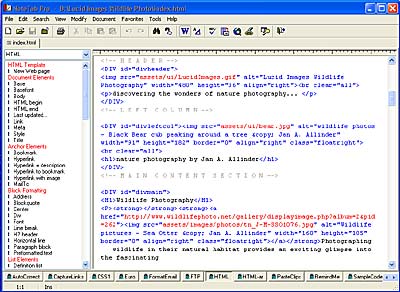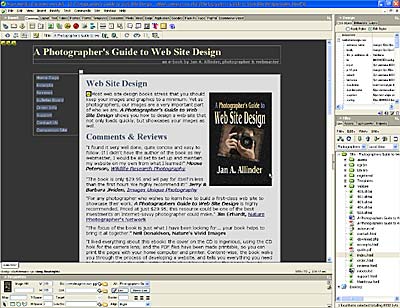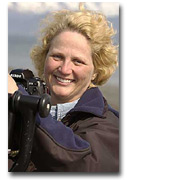Tools for Web Site Design
Copyright Jan Allinder. All rights reserved.
Ready to design or update your website? Letís go over some of the tools available for helping you put it all together.
What You Need
Unfortunately, there is not one program that does it all. Designing and maintaining a nature photography web site will require a minimum of three programs:
- Image Editor
- Text or WYSIWYG Editor
- FTP Client
Image Editor
Adobe Photoshop is the top choice among nature photographers for editing images. Donít worry if you canít afford Photoshop or donít need all the features Photoshop has to offer, there are other excellent image editors available. Adobe Photoshop Elements 2 is a reasonably priced alternative to Photoshop. Another option for PC users is PaintShop Pro. Both Elements and PaintShop Pro contain all the basic features you need and much more.
Text Editor
 Before the days of WYSIWYG (What You See Is What You Get) programs, a good text editor was essential. Text editors like NoteTab Pro (PC) and BBEdit (Mac) are great choices for editing HTML, CGI/Perl, JavaScript, ASP and PHP scripts. Theyíre also good for writing content for your web pages.
Before the days of WYSIWYG (What You See Is What You Get) programs, a good text editor was essential. Text editors like NoteTab Pro (PC) and BBEdit (Mac) are great choices for editing HTML, CGI/Perl, JavaScript, ASP and PHP scripts. Theyíre also good for writing content for your web pages.
A word of caution for Microsoft Word users: When you save a Word document as an HTML file, Word tends to add a few tags and ASCII codes which are unrecognized by browsers other than Internet Explorer. We suggest that you copy and paste text from Word rather than saving the file as a web page.
WYSIWYG Editors
Probably the easiest and quickest way to develop a web site is to use a WYSIWYG editor. The most popular programs for the PC are Macromedia Dreamweaver MX and Microsoft FrontPage. For the Mac, your best choices are Dreamweaver and Adobe GoLive.
Each of these programs has their plusses and minuses. I prefer Dreamweaver because:

- Dreamweaver produces very clean HTML code. It doesnít add extra tags that increase file size.
- Dreamweaver does not insert invalid syntax or propriety code assuring cross-browser compatibility.
- Dreamweaver is great for managing large sites. Keep in mind that while you might only have 3 or 4 pages to start, your site can end up well over 100 pages a few years down the road.
FTP Client
Once youíve designed your web site, youíll need a way to upload your pages and images to the Internet. WYSIWYG editors come with a built-in program to transfer your files. However, if youíre using a text editor, youíll need an FTP (file transfer protocol) client. For the PC, CuteFTP and WS_FTP Pro are excellent choices. Fetch is the recommended FTP client for Mac users.
CSS Editor
I believe in using the right tools to be more efficient in my job as a web site designer. Using Cascading Style Sheets, CSS, greatly simplifies the process of maintaining a web site. A CSS Editor is an indispensable tool for those who have more than one site or like to change the look and feel of their own sites on a regular basis. Either TopStyle Pro or Style Master is a good choice for this purpose.
Site Validation
One of the most important, yet one of the hardest tasks you must perform is to be sure your site will work properly on multiple platforms, browsers and monitors. An
HTML Style checker such as CSE HTML Validator will check your source code for any mistakes or possible discrepancies.
Link Validation
Thereís nothing more annoying than clicking on a link that is invalid. Thatís where programs such as Xenuís Link Sleuth are invaluable. Link Sleuth verifies your entire site for links to web sites, images, plug-ins, backgrounds, style sheets and java applets.
Web Graphics
If you plan to create a lot of web graphics such as buttons, logos, gifs or banners, Macromedia Fireworks is a great choice. Fireworks is one of the many programs included with Macromedia Studio MX.
Thumbnails & Galleries
Do you have a lot of images that you need to create thumbnails and pages for? One of the best tools for this purpose is Express Thumbnail Creator. Express Thumbnail Creator creates the thumbnails and the corresponding web pages for each of the images. If you only need to create a batch of thumbnail images, try Easy Thumbnails.
Flash
While Flash sites or Flash graphics can be quite impressive; the learning curve is as steep as the price tag. Iíve found SWiSH to be the perfect solution for creating simple Flash banners and graphics.
Summary
The programs listed here are just a few of the vast number of web site design tools available for designing and maintaining a photo intensive web site. You will need to find the combination of programs that help you create and maintain your web site in a relatively easy-to-understand / easy-to-use manner. As with learning nature photography, it takes time, practice and perseverance to achieve your goals. With this comes a great sense of pride and accomplishment.
Jan Allinder - NPN 015
Lucid Images Wildlife Photography
Comments on NPN web site design articles? Send them to the editor.

Jan Allinder is not only an avid nature photographer, but a talented webmaster as well. A member of the HTML Writers Guild, Jan thoroughly enjoys designing and creating web pages, including those for Moose Peterson, and Jerry and Barbara Jividen. Jan has been working with
computers for over ten years, and believes that the Internet is a fantastic place to learn, meet new
people and have a good time. Her primary goal when designing any web site is to help educate the public. Jan's e-book, A Photographer's Guide to Web Site Design is a resource of useful information for any nature photographer with an interest in building their own web site.
To view Jan's work, be sure to pay her Lucid Images Wildlife Photography web site a visit!


| 


